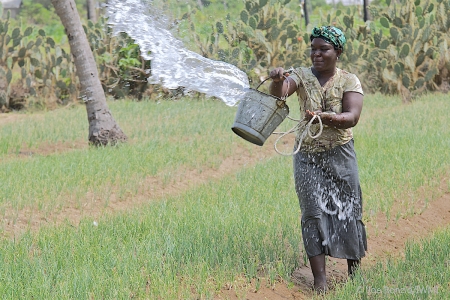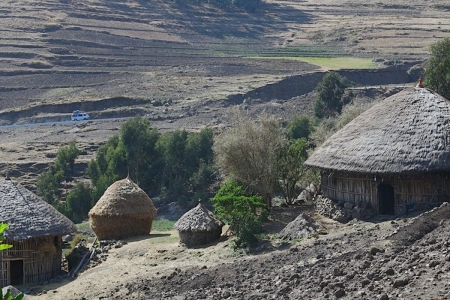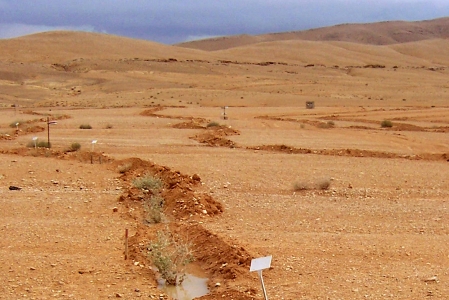Land grabbing is a topic of hot debate among scientists and development professionals. We received a comment on Fred Pearce’s land grabbing post that rightly points to what might be an even greater problem—water acquired along with land, or “water grabbing.” Tim Williams, from the International Water Management Institute, highlights the neglect of water availability and use in foreign land acquisitions in West Africa in his article "Water implications of large scale land acquisitions in Ghana."
In the wake of recent large-scale land acquisitions (LSLAs) by foreign investors engaged in biofuel and food crop production, much of the discussion about the suitability of Africa for foreign agricultural investment has been framed in terms of land rather than water availability. Yet land and water are interlinked resources. In the context of West Africa, examining the water dimensions of these LSLAs is important for a variety of reasons:
- First, in the sub-humid and semi-arid agro-ecological zones where the largest of these recent LSLAs occur, water availability underpins land productivity partly because of the high inter-annual and inter-seasonal fluctuations in rainfall.
- Second, the land use change that is inherent in the establishment of large-scale plantations is likely to influence hydrologic flows and processes such as infiltration, evapotranspiration and runoff which, in turn, will impact on ecosystem services and local livelihoods dependent on these services (see Kizito et al., 2012 for a conceptual model of these interactions).
- Third, access to water for agricultural production by smallholder farmers can be an important tool for poverty alleviation (Lipton et al., 2003).
- Fourth, although not always explicitly stated, expectations of secure access to water have been cited as one of the underlying reasons for large-scale acquisitions of land by states, such as Gulf countries, where renewable water resources are acutely limited (Woertz et al., 2008) and by rapidly growing emerging economies, such as China and India, where local water scarcity is beginning to emerge (de Fraiture et al., 2008).
Given the critical importance of water for local livelihoods, ecosystem services and long-term viability of foreign direct investment (FDI) in agricultural land and having reviewed the procedures and contracts of recent LSLAs, I set out to ask three simple questions which are elaborated below.
Why is water neglected in LSLA deals in West Africa?
In a paper focusing on LSLAs in Ghana that I coauthored with Gyampoh, Kizito and Namara, the underlying causes of this neglect include separate and parallel legal, policy and institutional frameworks for land and water governance—divorcing water from land acquisition procedures. Additional causes of neglect for water include a land acquisition process devoid of intervention of regulatory agencies at critical initial stages of negotiation (see figure below), lack of government-sanctioned assessment of current and future water requirements for crop production and ecosystem services, and land transaction practices that reflect power and information asymmetries between investors and customary land owners, on the one hand, and between customary land owners, represented by chiefs, and their subjects, on the other hand.
If the neglect of water in LSLA deals arises partly due to separate systems for administering land and water, the problem is further compounded by ambiguity of regulatory oversight of some institutions, poor policy coherence, and poor coordination of activities across institutions.
What are the consequences of ignoring water in LSLA deals?
We documented in Ghana and Mali (see Kizito et al., 2012) cases of displacement of poor farmers as a result of LSLAs leading to loss of access to land and associated water rights. This has directly affected the ability of these farmers to feed their families and earn income. Our studies also show that the water use impact assessments that companies acquiring large tracts of land are expected to undertake are divorced from land acquisition procedures. This often results in the poor monitoring and evaluation of the impact of their production activities on the ecological functions of freshwater ecosystems.
What needs to be done?
New institutional arrangements are needed in order to close the gap between policy and reality and to ensure that future LSLAs adequately consider crop water requirements and likely impacts on the livelihoods of smallholder users and the ecosystem. For these arrangements to be effective and workable, they must be based on social, political and economic realities.
In the West African context, this means anchoring the new institutional arrangements on a stronger, integrated and coordinated input from regulatory agencies, complemented by legislative reforms that recognize the rights of existing land and water users. Agencies need to coordinate input before and after large-scale land deals are approved. Before land deals are approved, rigorous water use impact assessments that include social, economic and environmental evaluation, will be needed. Once agricultural production and processing activities get underway, agencies will need to monitor, evaluate and ensure compliance with the impact mitigation measures developed and approved for each company.
It is critical for existing land and water users, whose livelihoods will be affected by LSLA deals, to participate in the negotiation process. Civil society and non-state actors will need to assist poor rights holders in organizing themselves to establish viable land and water users’ associations that can give them a voice on LSLA deals. It is also important to initiate legal literacy campaigns for illiterate stakeholders. Illiterate stakeholders need to be informed of their rights and processes for receiving compensation if their livelihoods are affected by LSLAs.
This complementary approach will tighten loopholes in the current process of large-scale land acquisition and will ensure better incorporation of water, equity and sustainability issues in future LSLA deals.
References
Kizito, F., Williams, T.O., McCartney, M. and Erkossa, T. 2012. Green and blue water dimensions of foreign direct investment in biofuel and food production in West Africa
https://www.tandf.net/articles/handbook_of_land_and_water_grabs_in_africa_featured_in_the_guardian/
https://www.water-alternatives.org/index.php?option=com_docman&task=doc_download&gid=168
Lipton, M., Litchfield, J. and Faurès. J-M. 2003. The effects of irrigation on poverty: a framework for analysis. Water Policy 5(2): 413-427.

















Comments
This article was well written and easy to follow. Interesting, clear and precise. I like this one Tim.
Excellent entry! It's always nice when you can not only be informed, but also entertained!